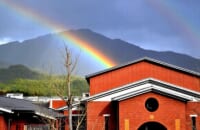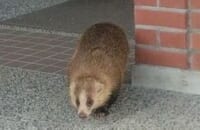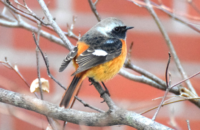
季節は着実に「夏」から「秋」へと移りかわり、ナツアカネは姿を消し、校内の樹々は日々、秋の装いに変化してきました。
西側の芝生地では、カリン(バラ科)の果実がたわわに実り、甘くかぐわしい芳香が気持ちをリラックスさせてくれます。
さて、「実り」は次なる世代へのバトンですが、植物の「果実」には、いったいどのような生存戦略が隠されているのでしょうか?
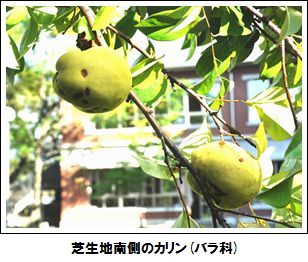
理科野外MSで育っているイチヂクの甘い実は、ヒヨドリやムクドリが目ざとく見つけ、ついばんでくれています。キンモクセイなどの香りには、ハエやハチが訪れ、花粉を媒介してくれています。甘さや独特の香り、花の形状などは、種子を運んでくれそうな動物たちを心待ちにしている姿なのです。
ところで、ヒトが栽培しているス-パ-の野菜や果物たちは、ヒトの好みや経済活動の視点から店先に並んでいますが、植物の側からみればより多く、拡散してくれればいいわけで、ヒトを巧みに利用して大成功を収めている植物たちと言えそうです。
次にス-パ-にお買い物に行ったときには、そこに並んでいる植物たちの巧みな戦略にも想いを馳せてみて下さい。
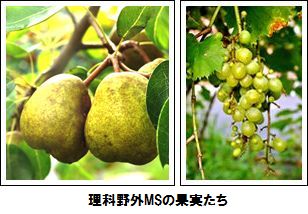
As we move from summer to autumn, the Summer Darter Dragonflies disappear and the trees around the school start to change. The Chinese Quince trees in the west of the school are bearing fruit that bring a relaxing fragrance to the area.
Speaking of bearing fruit for the next generation, what kind of secrets do plants rely on for their survival?
The Fig trees that are growing in the outdoor Science Media Space attract Brown-eared Bulbuls and Starlings that peck at the fruit. The Fragrant Orange-colored Olive trees attract flies and bees with their fragrances for them to carry away pollen. The trees use their sweetness and fragrances to trick the animals into spreading their seeds.
By the way, the fruit and vegetables that we get from the supermarket are there because we humans like them or because of economics, but it could be said that the plants are using humans to be spread to many places.
Next time you go to the supermarket, think about how the plants are carrying out their skillful strategy.
